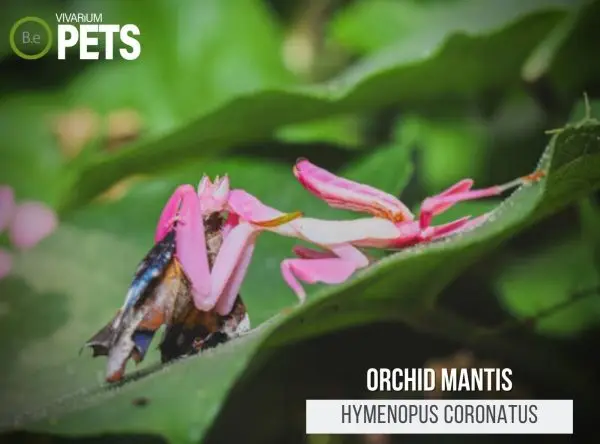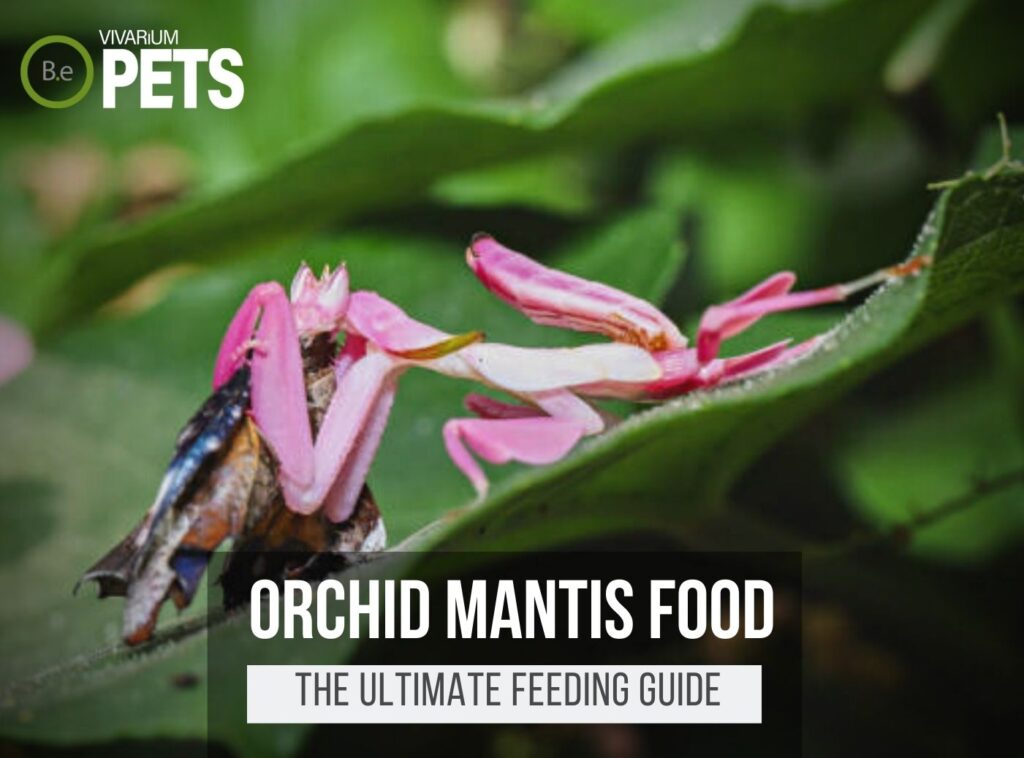It’s a pretty dangerous world for anything that was to avoid a predator that looks like a beautiful flower.
Lucky for us, we are too big to be on the hunting radar of the Orchid Mantis, or Hymenopus coronatus.
In this guide, you will learn everything you need to know about setting up a habitat and properly caring for your flower mantis.
So buckle up and let’s get started on our journey into the world of the miniature orchid look-a-like!
Table Of Contents:
ToggleWhat Is An Orchid Mantis?
The Orchid Mantis (Hymenopus coronatus) is a praying mantis that is native to tropical forests in Southeast Asia.
They are a part of the Hymenopodidae family and are also known as “flower mantises” or “orchid mantises” due to their striking resemblance to orchids.
With long, slim limbs and intricate patterns of white, pink, and green, they are beloved companions throughout the world.
The scientific name for the Orchid Mantis, “Hymenopus coronatus,” is derived from the Greek words for “membrane” and “crowned” which refers to the distinctive crown-like shape of the insect’s body.
What Does Orchid Mantis Look Like?
Hymenopus coronatus is one of the most spectacular species of mantis with its delicate orchid pattern.
The species grows to be around 2.5 inches long with remarkably long legs that allow it to reach its full height.
Its aerial perspective makes it appear much more like an orchid flower than a predatory insect.
Its diamond-shaped head houses two large eyes and a plethora of intricate features that would often go unnoticed by the naked eye.
The Orchid Mantis is famed for its vibrant coloring, being mostly light pink or white in hue with splashes of emerald green and bold black stripes.
Its coloring is so masterfully camouflaged that it almost perfectly blends with its surrounding environment.
Benefits Of Using Orchid Mantis
Having a Hymenopus coronatus in your terrarium provides numerous benefits.
First, Orchid mantises add an exotic and beautiful element to your enclosure.
Their bright coloration gives the facility a bold and unique look, sure to impress your guests.
Secondly, these mantises can help to keep insect pests at bay – their predatory habits mean that they feed primarily on other insects such as flies.
As a result, you can be sure that their presence will help to keep your tank clean and healthy.
Finally, they are incredibly interesting to watch!
These mantises are a playful species and will often display fascinating behaviors such as head-bobbing, tail twitching, and leg-waving.
All of these behaviors can be intriguing to observe, providing hours of entertainment.
With its stunning looks, pest control services, and fascinating behavior, the Orchid Mantis is the perfect addition to any vivarium.

Orchid Mantis Facts
Orchid mantises are arboreal insects native to Southeast Asia that display beautiful colors resembling a flower.
With a lifespan of about 6 months, they are typically calm with light handling but can become defensive if threatened or over-stressed.
They feed mainly on small live insects, and breeding is best done in humid terrariums with plenty of small sticks and bushes for them to hide and lay eggs on.
Habitat
Hymenopus coronatus is a species very similar to the stick insect native to Southeast Asia, specifically Malaysia, Thailand, Singapore, and the Philippines.
The Orchid Mantis’s natural habitat consists mainly of low-lying rainforests, where they have adapted to camouflage themselves among orchids and other vegetation.
They’re nighttime creatures and have evolved to hunt while the sun is down, using their raptorial forelegs to capture prey.
Create the perfect home for your mantis with our Customizable Mantis Enclosure Kits, designed to meet all their habitat needs.
Diet
Hymenopus coronatus is an insect that lives and thrives in tropical environments.
In their natural habitat, these colorful creatures feed mostly on other insects – particularly small flying insects such as moths, fruit flies, crickets, and bees.
As long as they get the right type of food, they are sure to survive and thrive!
In some cases, Orchid Mantis will even feed on bees that are attracted to the flower-like appearance of their own body!
Throughout the day, H. coronatus will feed on various insects flying near them, rarely even looking for other food sources.
They will usually remain motionless on flowers, waiting for their prey to arrive.
Once an unsuspecting insect comes close enough, they strike with impressive speed and accuracy, snatching it up.
While they mostly rely on small insect prey, it is not uncommon to see them feed on larger insects, such as butterflies or dragonflies.
Other food sources include mites, spiders, other mantises, and even small frogs.
On rare occasions, they will even feed on scavenged carcasses or dead insects they find on the ground.
Temperament
Hymenopus coronatus is not aggressive by nature, so it typically will not be a danger to humans or other animals.
Instead, they are rather shy and prefer to be left alone.
When approached by predators in the wild, they typically rely on their camouflage to blend in with their surrounding environment.
In captivity, they will often go into hiding when humans or other animals are nearby, and will more likely flee than fight in encounters with other animals.
Generally, they seem to be more docile creatures when housed in a proper environment.
Lifespan
The lifespan of Orchid Mantises can range between 6 months to one year, depending on their environment and available resources.
They typically go through several different stages in their lifetime, which are egg, nymph, adult, respiration, and death.
The eggs are usually laid in clusters on leaves, and they hatch into larvae.
At the larval stage, the mantis will grow to several times its original size, and they will molt multiple times as they continue to reach full adult size.
After the mantis has reached its full-grown size, it will usually reach sexual maturity within a few months.
The mating process is usually done during the evening when temperatures are low.
Breeding
The reproductive process of Orchid mantises begins with courtship, where the male taps the female’s abdomen with his antennae, followed by dancing and waving of their antennae in tandem.
When the female participates in the dance, it is a sign that she is receptive and willing to mate.
The male then wraps his abdomen around the female’s and the two will become fused.
At this point, the female will begin laying her eggs, which the male will then fertilize.
The eggs will then be dispersed in various locations around the habitat.
Once the eggs are laid, they will take between 3-4 weeks to mature and hatch.
Orchid mantis nymphs can take care of themselves once they have hatched and the parents will not stay around to care for the offspring.
After they hatch, nymphs will go through 5 to 6 molting stages before they become full-grown adults.
Through each of these stages, the mantis will molt and grow bigger until it has become an adult.
During each of these molting stages, it is important to ensure that the habitat has the appropriate amount of humidity and temperature for the mantis to successfully molt.
Where To Find Orchid Mantis
If you’re looking to purchase an Orchid Mantis, there are countless vendors available both online and in physical stores.
When selecting the insects, you should always search for captive-bred Orchid Mantes as they tend to be healthier than wild-captured specimens.
Additionally, it’s essential to keep an eye out for any signs of illness or injury in the animals, and always source from a reputable vendor.
Hymenopus coronatus can also be found in the wild, although it is not recommended to collect one from nature.
These incredible creatures are endangered in many parts of the world and can easily become stressed when taken from their natural environment.
If you choose to find one in the wild, always ensure that capture and release techniques are used to avoid any harm to the species.
Orchid Mantis Care
To care for an Orchid Mantis, it is important to provide the right substrate, humidity, food, and temperature for the habitat.
Be gentle when handling and maintaining regular feedings and cleanings.
Keep an eye out for any common issues, such as molting, stress, or infection.
With the right care, Hymenopus coronatus will be healthy and thriving!
Tank Requirements
When keeping Orchid Mantises, choosing the right tank is essential for providing a healthy habitat.
A standard terrarium or paludarium works perfectly, but make sure it is at least one gallon big so your Orchid Mantis can have enough room to move around.
Keep the humidity levels between 70% and 80%, as this is the ideal moisture for the insect.
The pH of the water and terrarium substrate should stay between 6.5 and 7.0, with hardness levels of about 20-50 ppm.
The optimum temperature range for the habitat is 23-30°C (73-86°F).
As for substrate, use peat moss, bark chips, or coco fiber, and make sure it is deep enough to facilitate the burrowing habit of Hymenopus coronatus.
For terrarium lighting, a simple LED bulb works best and should be kept on for 10-12 hours per day.
What Do Orchid Mantises Eat?
Feeding Hymenopus coronatus is a vital part of proper care. They are carnivores and an ambush predator, meaning they wait for prey to come to them.
In the wild, they typically catch smaller insects. To feed your Orchid Mantis, you should provide them with a variety of small live insects such as:
- Fruit flies
- Mealworms
- Crickets
- Cockroaches
- Beetles
Your Orchid Mantis should be fed daily, and you should only provide them with as much food as they can eat in a few hours.
To provide the most nutritious diet for your mantis, make sure to offer a varied diet with different insects.
If you’re looking for a more detailed approach to feeding these critters, be sure to check out my ultimate DIY Orchid Mantis food guide. I give a more in-depth explanation of the best foods and my favorite recipe.
Best Tankmates For Orchid mantises
Having tankmates for Hymenopus coronatus can be a wonderful and enriching experience.
But before introducing any tankmates to your Orchid Mantis, be sure to do your research and properly equip the tank.
Some of the best tankmates for an Orchid Mantis include peaceful and passive invertebrates, such as woodlice, springtails, and waxworms.
These animals are excellent food sources for H. coronatus and won’t cause any harm to it.
The presence of these invertebrates will also encourage the mantis to display its natural behaviors.
Conclusion
Congratulations! You are now an expert on Hymenopus coronatus care and know how to keep your pet happy and active.
We hope you have enjoyed this journey and gained a greater understanding and appreciation for these unique and wonderful creatures.
Your pet praying mantis will thank you for your attentive care and provide you with colorful beauty—enjoy him or her!
Create the ideal habitat for your praying mantis with our species-specific soil mixes and Insect Enclosure Kits. These products provide everything you need for a thriving Mantid habitat.
Frequently Asked Questions
No, orchid mantis bites are not known to be painful or harmful to humans.
yes, Hymenopus coronatus, also known as the Orchid Mantis, have the ability to fly short distances.
Orchid mantis are quite rare, and can often be difficult to find.
Yes, orchid mantises are relatively easy to care for due to their low maintenance requirements.
Yes, feeding your orchid mantis crickets is safe and recommended.
yes, Orchid mantes are generally docile and known to be gentle giants.
Orchid mantes are colorfully camouflaged in shades of pink, lavender, and white to resemble orchids while praying mantes are usually a mix of green and brown.
An orchid mantis camouflages to blend in with its environment to protect itself from predators.





